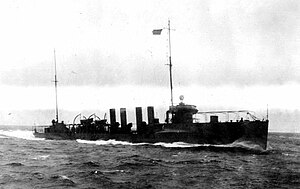 USS Porter (DD-59), undergoing trials, 8 March 1916
| |
| History | |
|---|---|
| Name | Porter |
| Namesake | David Dixon Porter |
| Ordered | 1913[3] |
| Builder | |
| Cost | $878,683.78 (hull and machinery)[4] |
| Yard number | 420[2] |
| Laid down | 24 August 1914[1] |
| Launched | 26 August 1915[1] |
| Sponsored by | Miss Georgiana Porter Cusachs[1] |
| Commissioned | 17 April 1916[1] |
| Decommissioned | 23 June 1922[1] |
| Stricken | 5 July 1934[1] |
| Identification |
|
| Fate |
|
| Notes | lost her name to new construction on July 1, 1933, referred to as DD-59 afterward |
| Name | Porter |
| Acquired | 7 June 1924[5] |
| Commissioned | 20 February 1925, Delaware Bay[5] |
| Decommissioned | 5 June 1933[5] |
| Identification | Hull symbol:CG-7 |
| Fate | returned to U.S. Navy, 30 June 1933[5] |
| General characteristics | |
| Class and type | Tucker-class destroyer |
| Displacement | |
| Length | 315 ft 3 in (96.09 m)[1] |
| Beam | 30 ft 7 in (9.32 m)[3] |
| Draft |
|
| Installed power |
|
| Propulsion | |
| Speed | |
| Complement | 5 officers 96 enlisted[6] |
| Armament |
|
USS Porter (Destroyer No. 59/DD-59) was a Tucker-class destroyer built for the United States Navy prior to the American entry into World War I. The ship was the second U.S. Navy vessel named in honor of both David Porter and his son David Dixon Porter.
Porter was laid down by the William Cramp & Sons of Philadelphia, in August 1914 and launched in August of the following year. The ship was a little more than 315 feet (96 m) in length, just over 30 feet (9.1 m) abeam, and had a standard displacement of 1,090 long tons (1,110 t). She was armed with four 4-inch (10 cm) guns and had eight 21 inch (533 mm) torpedo tubes. Porter was powered by a pair of steam turbines that propelled her at up to 29.5 knots (54.6 km/h).
After her April 1916 commissioning, Porter conducted her shakedown cruise in the Caribbean. After the United States entered World War I in April 1917, Porter was part of the first U.S. destroyer squadron sent overseas. Patrolling the Irish and Celtic Sea out of Queenstown, Ireland, Porter severely damaged the German submarine U-108 in April 1918.
Upon returning to the United States after the war, Porter operated off the east coast until she was decommissioned in June 1922. In June 1924, Porter was transferred to the United States Coast Guard to help enforce Prohibition as a part of the "Rum Patrol". She operated under the name USCGC Porter (CG-7) until 1933, when she was returned to the Navy. Later that year, the ship was renamed DD-59 to free the name Porter for another destroyer. She was sold for scrap in August 1934.
- ^ a b c d e f g h i j k Naval History & Heritage Command. "Porter". DANFS. Retrieved 23 April 2009.
- ^ "Porter (6105678)". Miramar Ship Index. Retrieved 23 April 2009.
- ^ a b c Gardiner, pp. 122–23.
- ^ "Table 21 - Ships on Navy List June 30, 1919". Congressional Serial Set. U.S. Government Printing Office: 762. 1921.
- ^ a b c d Cite error: The named reference
USCGwas invoked but never defined (see the help page). - ^ "Table 16 - Ships on Navy List June 30, 1919". Congressional Serial Set. U.S. Government Printing Office: 749. 1921.
- ^ a b "Table 10 - Ships on Navy List June 30, 1919". Congressional Serial Set. U.S. Government Printing Office: 714. 1921.